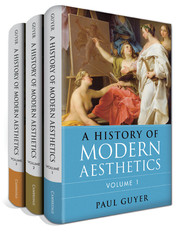Book contents
- Volume 1 The Eighteenth Century
- Volume 2 The Nineteenth Century
- Frontmatter
- Contents
- Acknowledgments
- Introduction
- Part One German Aesthetics in the First Half of the Nineteenth Century
- Part Two (Mostly) British Aesthetics in the Second Half of the Nineteenth Century
- Part Three German Aesthetics in the Second Half of the Nineteenth Century
- 8 In the Shadow of Schopenhauer
- 9 Neo-Kantian Aesthetics
- 10 Psychological Aesthetics
- Bibliography
- Index
- Volume 3 The Twentieth Century
- References
10 - Psychological Aesthetics
Play and Empathy
from Part Three - German Aesthetics in the Second Half of the Nineteenth Century
Published online by Cambridge University Press: 05 June 2015
- Volume 1 The Eighteenth Century
- Volume 2 The Nineteenth Century
- Frontmatter
- Contents
- Acknowledgments
- Introduction
- Part One German Aesthetics in the First Half of the Nineteenth Century
- Part Two (Mostly) British Aesthetics in the Second Half of the Nineteenth Century
- Part Three German Aesthetics in the Second Half of the Nineteenth Century
- 8 In the Shadow of Schopenhauer
- 9 Neo-Kantian Aesthetics
- 10 Psychological Aesthetics
- Bibliography
- Index
- Volume 3 The Twentieth Century
- References
Summary
As we saw previously, one thing that unified authors as diverse as Schelling, Hegel, Schopenhauer, and many of their followers was the rejection of the concept of aesthetic experience as a form of play that had been central to the aesthetics of Gerard, Kant, and Schiller in the eighteenth century, and that had then been revived by only a few writers in the nineteenth century, such as Schleiermacher, Dilthey, and perhaps Nietzsche, although only toward the end of his career. As we will see, an attack upon the notion of aesthetic experience as play would again become prominent in many quarters at the beginning of the twentieth century, notably in the aesthetics of Benedetto Croce, himself influenced by Kant in some regards but by Hegel in this regard, and by many influenced by him, especially in Great Britain. Were those philosophers just flogging a horse that had been killed a century earlier? By no means, because there was a revival of enthusiasm for the concept of play as the central concept of aesthetics among several writers in the second half of the nineteenth century. However, as we will see in due course, the character of the renewed attack on the theory of play that would follow its revival would be similar to the original attack of German Idealism against the theory of play in Kant and Schiller: the idea that aesthetic experience involves the pleasurable play of our powers, including our cognitive powers, but not for the sake of cognition or any other determinate goal, would once again be rejected in favor of the theory that aesthetic experience is itself an important form of cognition.
- Type
- Chapter
- Information
- A History of Modern Aesthetics , pp. 378 - 438Publisher: Cambridge University PressPrint publication year: 2014



